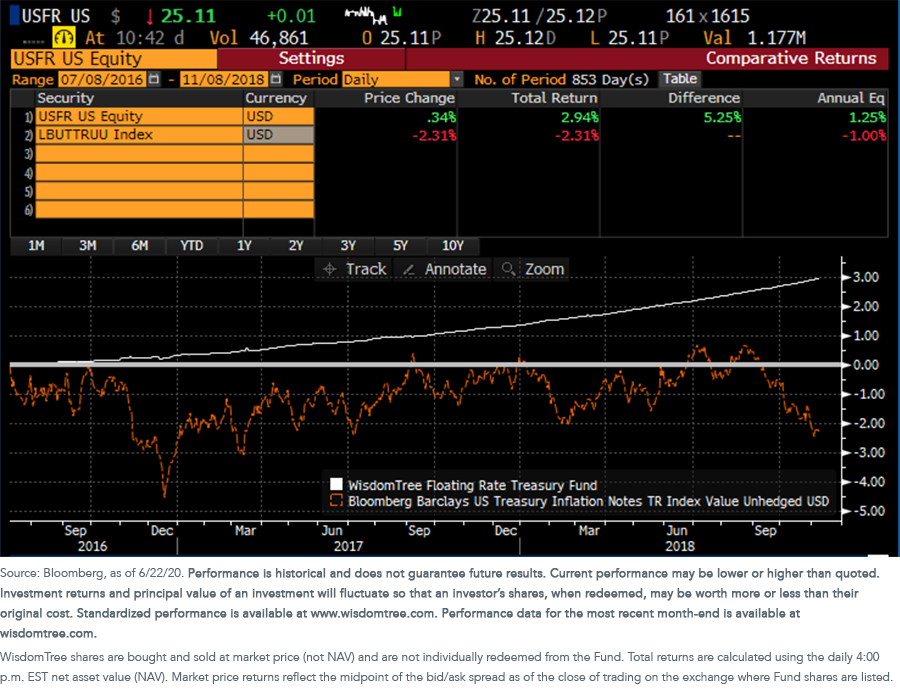Leaving a TIP


I know now may not be the time investors are thinking about an interest rate hedging angle for their bond portfolio, but maybe it should be. Typically, reallocating funds to ward off potential interest rate risk occurs when the upward trend is already in place. This is exactly the scenario I’d like to see investors avoid repeating. In other words, the time to consider rate protection is when rates are low, just as they are now!
I’ll be the first to admit that my base case for rates is that they stay lower for longer. No argument there. However, that doesn’t mean U.S. Treasury (UST) yields can’t rise from their current historically low levels. That is what we bond guys call “statement risk”—you know, a client receives their monthly financial statement, and in the fixed income section, they see “red” (negative performance).

For standardized performance of USFR, please click here.
So, how do fixed income investors search for rate-hedging solutions? One approach that one often encounters involves U.S. Treasury (UST) Inflation-Protected Securities, or TIPS. These securities are referenced to the Consumer Price Index (CPI), whereby the coupon is fixed, but the principal is adjusted to changes in CPI.
Interestingly, TIPS do not necessarily offer investors the most beneficial strategy for potentially higher rates. These instruments are designed to protect investors from the effects of higher inflation, which can certainly play a role in pushing rates higher, but they do not necessarily act as a full hedge on this front. Indeed, these instruments tend to be a bit longer-duration in nature, as well. To provide some perspective, the Bloomberg Barclays US Treasury Inflation Notes Modified Adjusted Duration Index stands at 4.09 years, as of this writing. Only a month ago, this reading was more than double, at 8.69 years. So, while they may outperform a nominal UST 10-year as an example, if intermediate to longer-term rates do rise, TIPS may still experience some negative effects.
Let’s contrast this strategy to one involving UST floating rate notes (FRNs). These securities are referenced to the weekly UST three-month t-bill auction, with the interest rate floating/adjusting to this offering’s result, and essentially carry a duration of one week. Thus, UST FRNs are more directly tied to changes in interest rates, specifically Federal Reserve (Fed) rate moves, while TIPS are more directly tied to changes in inflation.
Given the unprecedented amounts of fiscal and monetary policy stimulus, one could argue that inflation may rear its ugly ahead at some point in the years to come. However, in the meantime, Fed Chairman Powell & Co. have made it abundantly clear of late there is no appetite to contemplate raising the Fed Funds target anytime soon. Thus, as the U.S. economy begins to recover, it looks as if the Fed will let it “run hot”—i.e., they will tolerate an uptick in inflation for longer than they normally would. Add in some incredible Treasury supply to finance multitrillion-dollar budget deficits, and you have the ingredients for the UST 10-year yield to retrace some of this year’s decline.
The graph above highlights how the WisdomTree Floating Rate Treasury Fund (USFR), which is based on UST FRNs, outperformed the Bloomberg Barclays US Treasury Inflation Notes TR Index by 525 basis points (bps) at NAV during the most recent rising yield period from July 8, 2016 through November 8, 2018. I certainly don’t expect the magnitude of rate increase to be at that level, but the graph highlights how these two strategies differed in terms of rate protection.
Conclusion
Ask yourself the question: What if the UST 10-year yield retraces 50% of this year’s decline and heads back toward 1.25% (not an unreasonable scenario)? That is nearly double the yield of where the 10-year stands now. Considering how TIPS and UST FRNs have performed in past rising rate periods, I’d “leave the TIP” and choose USFR.
Unless otherwise stated, all data sourced is Bloomberg, as of June 22, 2020.
Important Risks Related to this Article
There are risks associated with investing, including possible loss of principal. Securities with floating rates can be less sensitive to interest rate changes than securities with fixed interest rates, but may decline in value. The issuance of floating rate notes by the U.S. Treasury is new and the amount of supply will be limited. Fixed income securities will normally decline in value as interest rates rise. The value of an investment in the Fund may change quickly and without warning in response to issuer or counterparty defaults and changes in the credit ratings of the Fund’s portfolio investments. Due to the investment strategy of this Fund, it may make higher capital gain distributions than other ETFs. Please read the Fund’s prospectus for specific details regarding the Fund’s risk profile.


